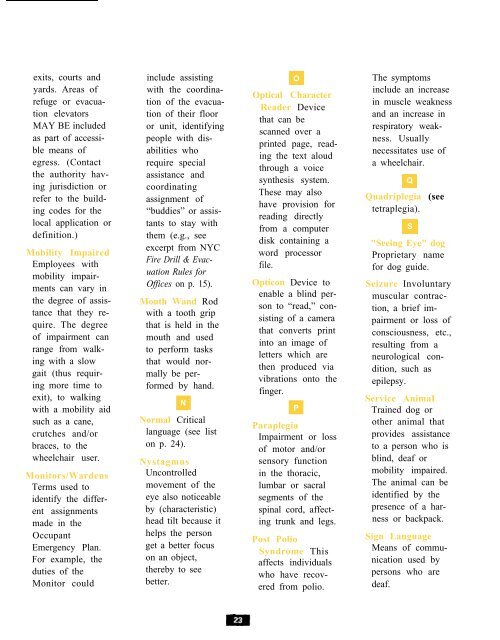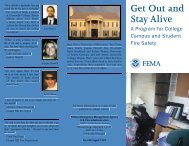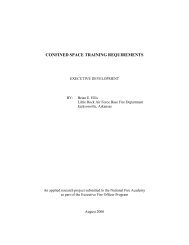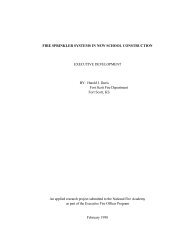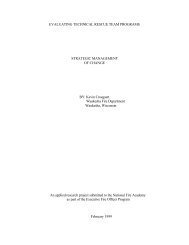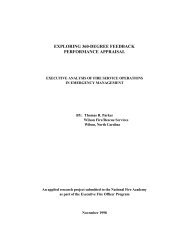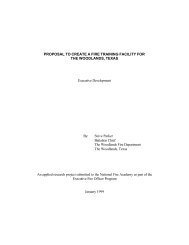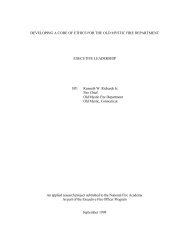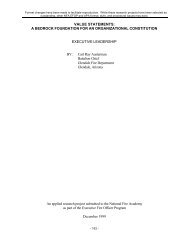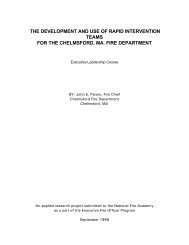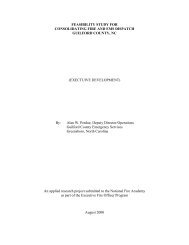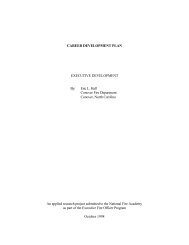Emergency Procedures for Employees with Disabilities - US Fire ...
Emergency Procedures for Employees with Disabilities - US Fire ...
Emergency Procedures for Employees with Disabilities - US Fire ...
You also want an ePaper? Increase the reach of your titles
YUMPU automatically turns print PDFs into web optimized ePapers that Google loves.
exits, courts and<br />
yards. Areas of<br />
refuge or evacuation<br />
elevators<br />
MAY BE included<br />
as part of accessible<br />
means of<br />
egress. (Contact<br />
the authority having<br />
jurisdiction or<br />
refer to the building<br />
codes <strong>for</strong> the<br />
local application or<br />
definition.)<br />
Mobility Impaired<br />
<strong>Employees</strong> <strong>with</strong><br />
mobility impairments<br />
can vary in<br />
the degree of assistance<br />
that they require.<br />
The degree<br />
of impairment can<br />
range from walking<br />
<strong>with</strong> a slow<br />
gait (thus requiring<br />
more time to<br />
exit), to walking<br />
<strong>with</strong> a mobility aid<br />
such as a cane,<br />
crutches and/or<br />
braces, to the<br />
wheelchair user.<br />
Monitors/Wardens<br />
Terms used to<br />
identify the different<br />
assignments<br />
made in the<br />
Occupant<br />
<strong>Emergency</strong> Plan.<br />
For example, the<br />
duties of the<br />
Monitor could<br />
include assisting<br />
<strong>with</strong> the coordination<br />
of the evacuation<br />
of their floor<br />
or unit, identifying<br />
people <strong>with</strong> disabilities<br />
who<br />
require special<br />
assistance and<br />
coordinating<br />
assignment of<br />
“buddies” or assistants<br />
to stay <strong>with</strong><br />
them (e.g., see<br />
excerpt from NYC<br />
<strong>Fire</strong> Drill & Evacuation<br />
Rules <strong>for</strong><br />
Offices on p. 15).<br />
Mouth Wand Rod<br />
<strong>with</strong> a tooth grip<br />
that is held in the<br />
mouth and used<br />
to per<strong>for</strong>m tasks<br />
that would normally<br />
be per<strong>for</strong>med<br />
by hand.<br />
N<br />
Normal Critical<br />
language (see list<br />
on p. 24).<br />
Nystagmus<br />
Uncontrolled<br />
movement of the<br />
eye also noticeable<br />
by (characteristic)<br />
head tilt because it<br />
helps the person<br />
get a better focus<br />
on an object,<br />
thereby to see<br />
better.<br />
O<br />
Optical Character<br />
Reader Device<br />
that can be<br />
scanned over a<br />
printed page, reading<br />
the text aloud<br />
through a voice<br />
synthesis system.<br />
These may also<br />
have provision <strong>for</strong><br />
reading directly<br />
from a computer<br />
disk containing a<br />
word processor<br />
file.<br />
Opticon Device to<br />
enable a blind person<br />
to “read,” consisting<br />
of a camera<br />
that converts print<br />
into an image of<br />
letters which are<br />
then produced via<br />
vibrations onto the<br />
finger.<br />
P<br />
Paraplegia<br />
Impairment or loss<br />
of motor and/or<br />
sensory function<br />
in the thoracic,<br />
lumbar or sacral<br />
segments of the<br />
spinal cord, affecting<br />
trunk and legs.<br />
Post Polio<br />
Syndrome This<br />
affects individuals<br />
who have recovered<br />
from polio.<br />
The symptoms<br />
include an increase<br />
in muscle weakness<br />
and an increase in<br />
respiratory weakness.<br />
Usually<br />
necessitates use of<br />
a wheelchair.<br />
Q<br />
Quadriplegia (see<br />
tetraplegia).<br />
S<br />
"Seeing Eye" dog<br />
Proprietary name<br />
<strong>for</strong> dog guide.<br />
Seizure Involuntary<br />
muscular contraction,<br />
a brief impairment<br />
or loss of<br />
consciousness, etc.,<br />
resulting from a<br />
neurological condition,<br />
such as<br />
epilepsy.<br />
Service AnimaI<br />
Trained dog or<br />
other animal that<br />
provides assistance<br />
to a person who is<br />
blind, deaf or<br />
mobility impaired.<br />
The animal can be<br />
identified by the<br />
presence of a harness<br />
or backpack.<br />
Sign Language<br />
Means of communication<br />
used by<br />
persons who are<br />
deaf.


